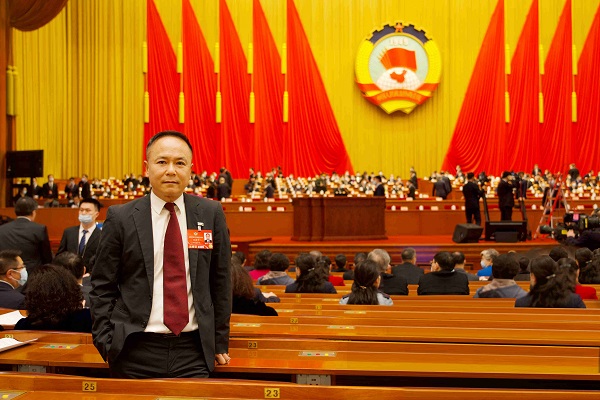CPPCC member Shen Guojun attends CPPCC meeting with proposals on marine environmental protection, digitalization and asset securitization
Release Date:March 5,2022
Views:2802
The Fifth session of the 13th National Committee of the CPPCC commenced on March 4. Shen Guojun is a member of the CPPCC, and a member of the Standing Committee of the Central Committee of China Zhigong Party. He is also Founder and Chairman of Yintai Group and Executive Chairman of The Paradise Foundation. This year, centered on the topics of systematic establishment of marine reserves, courts using digital technology to handle cases, and commercial real estate securitization, Shen submitted three proposals, namely Proposal for Improving the Establishment of China’s Marine Reserves and Advancing Maritime Power Strategy, Proposal for the Court to Adopt Blockchain Technology, and Achieve Mass Judicial Confirmation, and Proposal for Accelerating Commercial Real Estate Securitization so as to Contribute to Promoting Domestic Demand and Stabilizing Employment.

In the 10 years of performing his duty as a member of the 11th and 13th National Committees of the CPPCC, Shen has continued to focus on key issues in the business, technology, environmental and public interest sectors, and has taken the initiative to offer his advice and recommendations. His is a voice directly from the grassroots, and he aims to contribute to high-quality and sustainable socioeconomic growth.
(1) Multi-party collaboration to improve the establishment of marine reserves
China has jurisdiction over 3 million square kilometers of maritime space, but its total area of marine reserves at all levels is only approximately 124,000 square kilometers. Intensifying climate change trends and increased maritime development by the human race have made marine ecosystem vulnerabilities increasingly prominent. More and better connected marine reserves with more rigorous management and control are required to safeguard the security of China’s marine ecosystem.
At this time, the establishment of marine reserves in terms of protection quality, comprehensive effectiveness, monitoring technology, public awareness and many other areas requires further improvement.
Shen recommends that:
1. Overall planning for the protection of marine reserves nationwide should be enhanced and marine reserve planning should be organically integrated into national land and spatial planning as well as coastal belt protection and utilization planning. By leveraging institutions of higher learning, research institutes, high-tech enterprises, and other collaborative mechanisms that jointly contribute to long-term scientific research, a marine natural reserve think tank should be set up, and collaborative mechanisms for multiple stakeholders be created.
2. The border positions of all marine reserves nationwide and their corresponding oversight functions should be identified, and existing effectiveness evalsuation and adaptive management mechanisms for marine reserves should be enhanced. The level of management of and amount of commitment toward marine reserves should be comprehensively raised.
3. Comprehensive research into the unique ecology of marine reserves, as well as the economic, social and cultural values should be enhanced, and organically integrated into the management process of marine reserves so that the comprehensive effectiveness of marine reserves may be brought to play.
4. Social capital should be introduced and invested in researching, establishing and operating marine reserves, and a special fund for the scientific monitoring of marine reserves set up. By leveraging big data, artificial intelligence and other transformative advanced technology, and integrating monitoring methods for water surface, underwater, and remote sensing satellite, among others, and monitoring positions such as the surrounding waters of as well as runoffs in and internally within the reserves, an integrated pilot “sea, land and air” monitoring technology system for marine reserves should be advanced.
(2) Blockchain technology should be used to enable the Chinese courts to conduct mass judicial recognition online
Handling conflicts and resolving disputes have gradually become important contents for improving social governance. In recent years, Chinese courts at all levels have been promoting the “Fengqiao experience” (mobilizing the masses to strengthen dictatorship over class enemies). This has led to widespread implementation of the mediation system, which has played a key role in a large number of cases with a high degree of homogeneity. Nonetheless, the task of judicial recognition upon the successful mediation of these cases still results in quite a lot of trial pressure for the courts.
In recent years, with the promulgation of the Electronic Signature Law, some local courts have attempted to use electronic signature, electronic evidence and other digital technology to conduct mass online mediation. This has significantly increased mediation efficiency, and built up a certain amount of technological foundation and practical experience in “self-verification” via blockchain by using electronic evidence.
Shen recommends that:
Local courts, which use the internet court and mediation mechanisms widely, should be used as pilots. When handling cases that are designated, blockchain technology should be applied to the judicial recognition of electronic mediation agreements. By connecting mediation platform systems that meet technical standards, oversight is carried out for the online mediation process, as well as for mediation agreements and other documents. This dispenses with the re-verification of uplink electronic mediation agreements during judicial recognition, which will further strengthen the processing efficiency of post-mediation judicial recognition.
(3) Commercial real estate securitization should be accelerated by way of legislature, oversight and REIT pilots
In the last two years, the impact of online consumption and COVID-19 has caused many domestic shopping centers, hotels, offices and other commercial real estate to passively cut rents to withstand risks. Many commercial complexes have raised their operational and management capabilities by strengthening online promotions, livestream selling, and pursuing the night market economy, among others, to rise above market adversity. The investment value of securitized equity related assets is becoming increasingly recognized.
Under the present macro policy directive of “switching from old to new growth drivers and promoting high-quality development”, commercial real estate is transforming from the production and sales model of the past to an “asset management + operation” model. This calls for improving the operational and management capabilities to add value to assets. Promoting commercial real estate securitization has become a general trend.
Although the investment, operation, valuation and exit rationales for commercial real estate are fundamentally different from that of residential real estate, collateral damage resulting from the residential real estate market’s “owner occupation rather than for speculation” has meant that an enormous stock of quality assets built up in the commercial real estate sector could not be securitized so that a virtuous circulation of capital may be achieved. The development experience of mature overseas markets tells us that commercial real estate securitization not only helps tap the full potential of existing assets and capital built up over time, but also helps expand the direct financing channels of the real estate holders, thus boosting the efficiency and effectiveness of resource allocations in the financial market. For investors, this also enhances asset allocations channels, and has important significance for the building and development of a multi-tier capital market.
From another perspective, the successful launch of China’s public offering of infrastructure REITs (real estate investment trusts) provides positive references for commercial real estate securitization.
On this basis, Shen believes that the time is ripe for accelerating commercial real estate securitization. However, the legal system, oversight, tax and other relevant policies need to be further improved.
Shen recommends that:
1. The legal environment for commercial real estate securitization must be improved. REIT products span both the underlying real estate and the financial sector. Its requirements on operations and management as well as financial investment are fairly stringent. Issues pertaining to indistinct division of responsibilities at all segments are still common among existing products that have been issued. Therefore, legislation for REITs should be enhanced as soon as possible. The class and attribute of investable financial assets of a similar nature in REITs should be clarified, and the lines of responsibilities of fund managers and operating managers should be distinctly delineated. It is also advised that supporting tax policies relevant to REITs should be improved from the perspectives of land VAT, stamp duties and income tax.
2. The regulatory system for commercial real estate securitization should be enhanced. On the one hand, the establishment of an asset appraisal and credit evalsuation system should be accelerated, and the evalsuation of, among others, the cash flow and management of REIT enterprises should be fully leveraged. On the other hand, supervision and guidance on information disclosure by innovative products similar to REITs should be strengthened. The completeness, timeliness and accuracy of information disclosure of these products should be on a par with other more mature standardized products that are in the market.
3. Drawing from the successful experience of the public offering of infrastructure REITs, the commercial real estate sector should launch pilot public offering of REITs. It is also advised that enterprises with ample asset reserves, rich asset operational and management experience, and stable operations at the underlying company level be given preference for participating in the pilot program. During the pilot process, it is advised that the relevant regulators promptly introduce a pertinent package of supporting tax policies so that commercial real estate securitization can be large scale, standardized and sustainable.
4. Participants should be advised to pay attention to the quality of the underlying asset and focus on the basic concept of “asset financing”. Asset financing, typified by asset securitization, has become an increasingly important financing measure relied upon by numerous enterprises. Its core financing capability should be dependent on the quality of the fundamental assets of the enterprise. Therefore, it is advised that corresponding measures be introduced on the policy front to guide the relevant REIT participants to pay more attention to the quality of the underlying asset. Meanwhile, real estate owners or asset managers should be given guidance to create core competitiveness for REIT products by raising asset operational and management capabilities.







